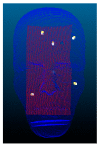An Augmented Reality System Using Improved-Iterative Closest Point Algorithm for On-Patient Medical Image Visualization
- PMID: 30071645
- PMCID: PMC6111829
- DOI: 10.3390/s18082505
An Augmented Reality System Using Improved-Iterative Closest Point Algorithm for On-Patient Medical Image Visualization
Abstract
In many surgery assistance systems, cumbersome equipment or complicated algorithms are often introduced to build the whole system. To build a system without cumbersome equipment or complicated algorithms, and to provide physicians the ability to observe the location of the lesion in the course of surgery, an augmented reality approach using an improved alignment method to image-guided surgery (IGS) is proposed. The system uses RGB-Depth sensor in conjunction with the Point Cloud Library (PCL) to build and establish the patient's head surface information, and, through the use of the improved alignment algorithm proposed in this study, the preoperative medical imaging information obtained can be placed in the same world-coordinates system as the patient's head surface information. The traditional alignment method, Iterative Closest Point (ICP), has the disadvantage that an ill-chosen starting position will result only in a locally optimal solution. The proposed improved para-alignment algorithm, named improved-ICP (I-ICP), uses a stochastic perturbation technique to escape from locally optimal solutions and reach the globally optimal solution. After the alignment, the results will be merged and displayed using Microsoft's HoloLens Head-Mounted Display (HMD), and allows the surgeon to view the patient's head at the same time as the patient's medical images. In this study, experiments were performed using spatial reference points with known positions. The experimental results show that the proposed improved alignment algorithm has errors bounded within 3 mm, which is highly accurate.
Keywords: head-mounted display; image alignment; improved-ICP algorithm.
Conflict of interest statement
The authors declare no conflict of interest.
Figures













References
-
- Kundu S.N., Muhammad N., Sattar F. Using the augmented reality sandbox for advanced learning in geoscience education; Proceedings of the 2017 IEEE 6th International Conference on Teaching, Assessment, and Learning for Engineering (TALE); Hong Kong, China. 12–14 December 2018; pp. 13–17.
-
- Ashfaq Q., Sirshar M. Emerging trends in augmented reality games. Computing, Mathematics and Engineering Technologies; Proceedings of the 2018 International Conference on Computing, Mathematics and Engineering Technologies (iCoMET); Sukkur, Pakistan. 3–4 March 2018; pp. 1–7.
-
- Virtual Reality. [(accessed on 16 February 2018)]; Available online: https://www.wareable.com/vr/how-does-vr-work-explained.
-
- Traub J., Sielhorst T., Heining S., Navab N. Advanced Display and Visualization Concepts for Image Guided Surgery. J. Disp. Technol. 2008;4:483–490. doi: 10.1109/JDT.2008.2006510. - DOI
MeSH terms
LinkOut - more resources
Full Text Sources
Other Literature Sources
Medical

